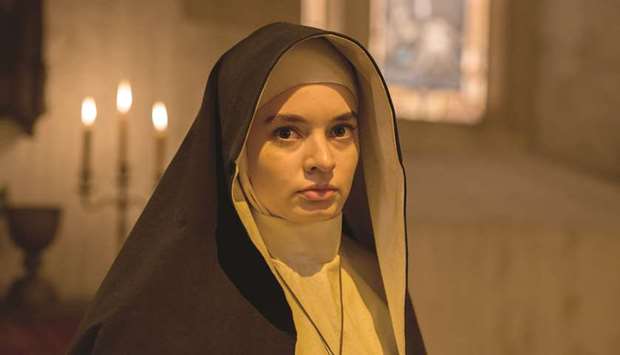I don’t invoke the subject of real-life abuse lightly; during the brief, dull-ish stretches between this movie’s relentless jolts, it was hard to think about much else. Whether we should view The Nun as a timely entertainment or a spectacularly ill-timed one is open to debate, one that will presumably be settled by box-office receipts. More than anything, though, the seemingly endless abuse controversies now engulfing the Roman Catholic Church make this prequel to 2013’s hit The Conjuring feel like exactly what it perhaps was always intended to be: a cheap, exploitative diversion.
Not that there’s anything inherently wrong with exploitation. Horror remains perhaps the most metaphorically suggestive of movie genres: Think of the rampaging zombie hordes in Night of the Living Dead or the smiling faces in Get Out, which can take on the weight of a culture’s unarticulated fears and repressed traumas. But the sinister sisterhood we meet in The Nun doesn’t allude to anything deeper or darker lurking beyond the frame. The movie trades in noisy, assaultive jolts that are quick to attack and even quicker to dissipate.
Written by Gary Dauberman (of the Annabelle movies, another branch of the Conjuring tree), The Nun unfolds within the cloistered ruins of a Romanian convent in 1952. A nun has committed suicide, and a weary priest, Father Burke (Demián Bichir) and a fresh-faced novitiate, Sister Irene (Taissa Farmiga), have come to investigate.
Guided by an irreverent local skeptic who goes by Frenchie (Jonas Bloquet, in flirty comic-relief mode), the two make an enchantingly odd detective duo, though it soon becomes clear that they were hand-chosen by the Vatican based on their own past tussles with the occult: Father Burke is regularly gripped by flashbacks to a failed exorcism, Sister Irene by terrifying visions of a more mysterious nature.
Those visions tend to confuse more than they clarify. From the moment Father Burke and Sister Irene set foot inside the abbey, an enormous castle that resembles a mausoleum, they find themselves steadily losing their grip on reality. Are they being driven mad, or is someone actually skittering in and out of their quarters at night? As the pair excavate secrets from a nearby graveyard and dig into the abbey’s subterranean catacombs, they pick up on signs and whispers of a nameless evil lurking within.
The movie’s most (ahem) habitual boo tactic is to have a black-robed figure or several suddenly materialise in the background, often photographed from behind in a way that deliberately frustrates our sense of who’s who. (Exactly how many nuns are actually on the premises is one of the movie’s more intriguing mysteries.) Are these sisters benevolent guardians sent to protect our heroes, or are they satanic minions?
There is little room for ambiguity on that score when it comes to the big, bad Nun herself (the mesmerising Bonnie Aarons), a hooded banshee who sadly isn’t billed in the credits as Sister Marilyn Manson. This hideous creation first emerged as a creepy footnote in The Conjuring 2, referenced as an old nemesis of that movie’s heroine, the paranormal investigator Lorraine Warren. Since Lorraine was played by Farmiga’s older sister, Vera, it’s fair to conclude that Lorraine and Irene are one and the same — or is it? The Conjuring Cinematic Universe, as we are now expected to think of it, is playfully, maddeningly coy on the subject.
The Lorraine/Irene question will almost certainly be taken up in a sequel, which at this point feels more like a threat than a promise. The Nun, shot in murky pools of darkness that often leave you squinting at the screen, is a dispiriting reminder that franchising evil inevitably dissipates its impact.
Despite its clammy atmosphere and two credible and appealing leads, the movie is mechanical in its rhythms and unimaginative in its terrors. The director, Corin Hardy, borrows a few clever handheld camera tricks from The Conjuring’s James Wan, but he isn’t in the same virtuosic league; he can’t turn this relentless succession of frights into a sustained, shivery bliss-out.
The two Conjuring movies, of course, benefited from a touch of working-class realism, set as they were in drab, ramshackle homes that were haunted as much by economic ruin as they were by any devilish influence. The Nun, by contrast, is mining more familiar religio-gothic-horror territory. That’s to be expected, of course.
The movie industry may not care about faith any more than it cares about anything it can exploit for commercial gain. But such horror cinema, much as it often spirals into camp silliness, is still one of the few subgenres in which Hollywood bothers to address such belief. It’s why The Exorcist has long been not just one of the great horror films, but one of the great religious films as well — a picture in which the central conflict is not demonic, but epistemological.
The Nun, which drops frequent and rather desperate allusions to The Exorcist, pays tribute to this grand tradition without exactly honouring it. It leaves you wondering if this is how this overstretched series ends — not with a bang, but a wimple. — Los Angeles Times/TNS



